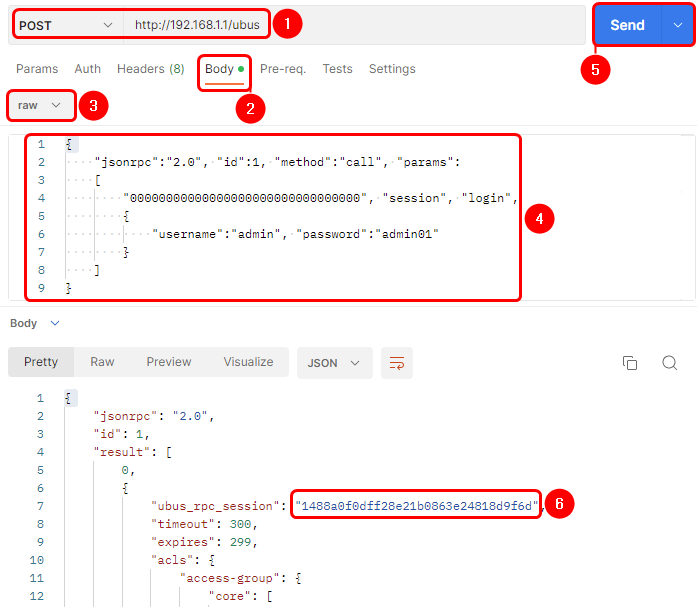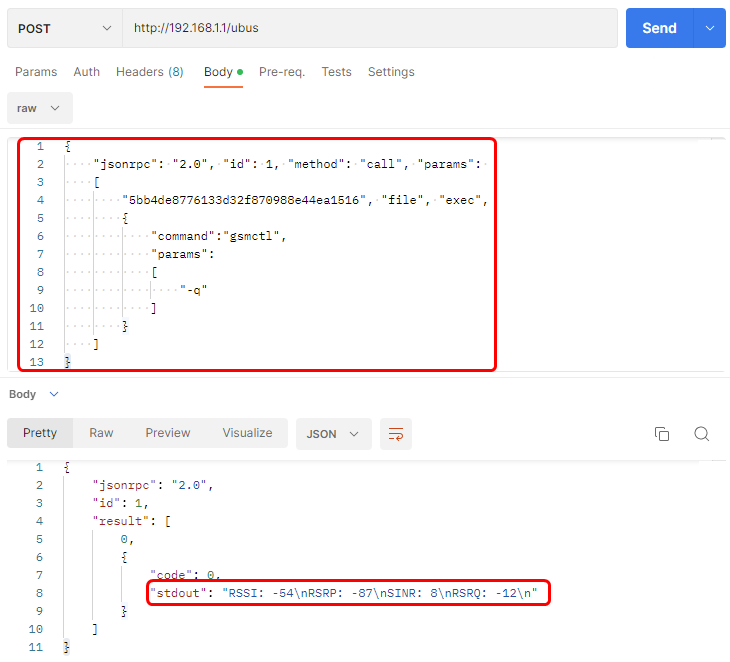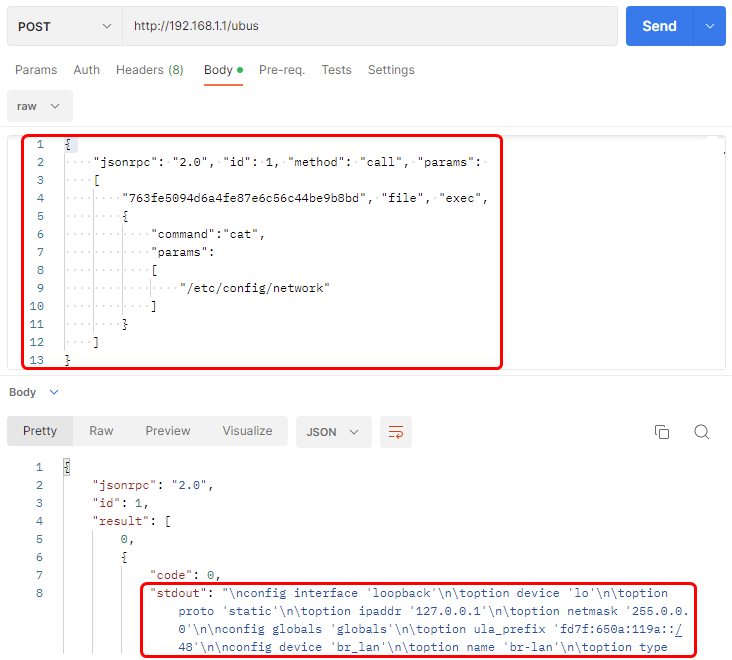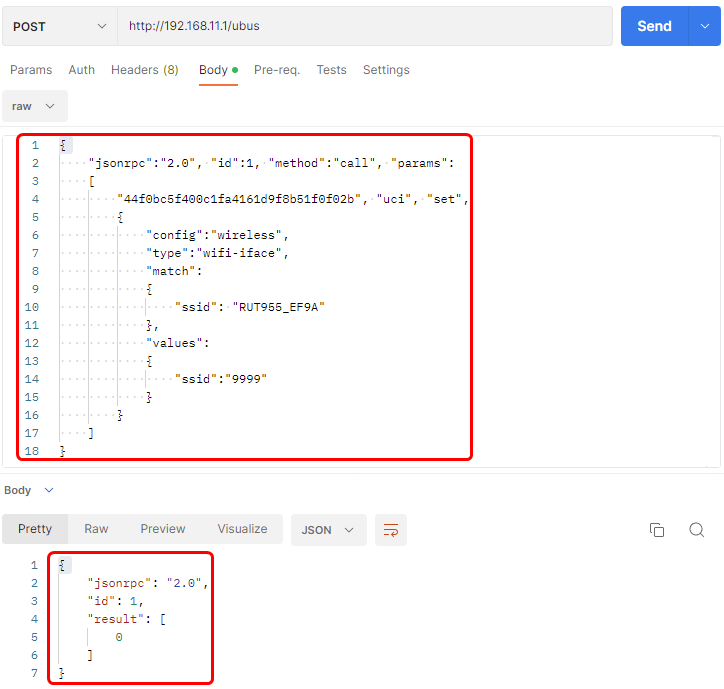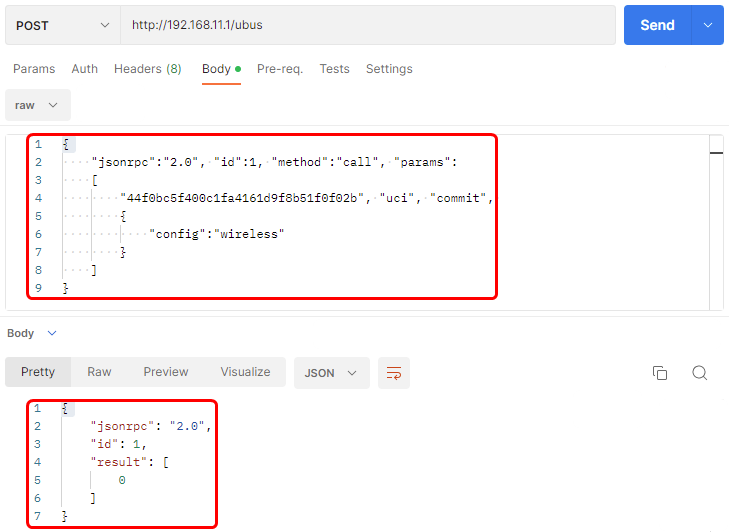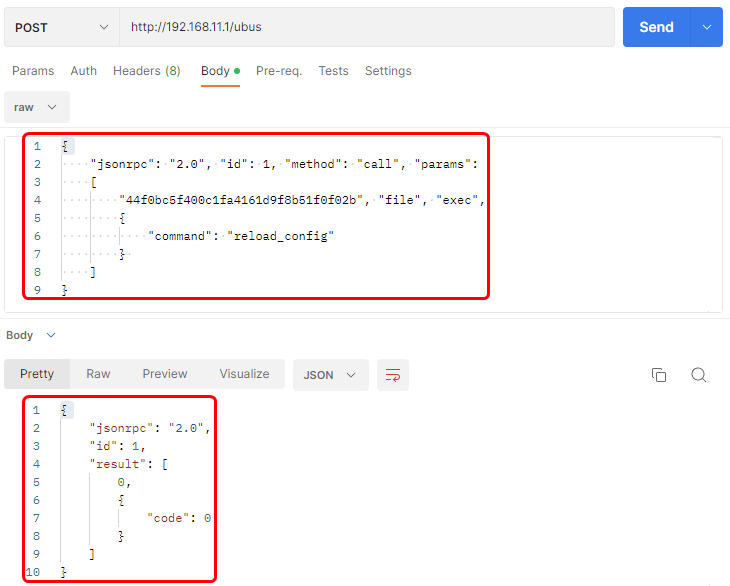Difference between revisions of "Monitoring via JSON-RPC windows RutOS"
(Changed luci-reload command to reload_config.) |
PauliusRug (talk | contribs) |
||
| (6 intermediate revisions by 2 users not shown) | |||
| Line 1: | Line 1: | ||
| + | <p style="color:red">The information on this page is updated in accordance with the [https://wiki.teltonika-networks.com/view/FW_%26_SDK_Downloads'''00.07.4'''] firmware version .</p> | ||
==Introduction== | ==Introduction== | ||
| − | |||
'''JSON-RPC''' is a remote procedure call protocol encoded in JSON. It is a very simple protocol (and very similar to XML-RPC), defining only a few data types and commands. JSON-RPC allows for notifications (data sent to the server that does not require a response) and for multiple calls to be sent to the server which may be answered out of order. | '''JSON-RPC''' is a remote procedure call protocol encoded in JSON. It is a very simple protocol (and very similar to XML-RPC), defining only a few data types and commands. JSON-RPC allows for notifications (data sent to the server that does not require a response) and for multiple calls to be sent to the server which may be answered out of order. | ||
| Line 27: | Line 27: | ||
---- | ---- | ||
First, you must obtain a '''Session ID'''. In order to do so, you must send a HTTP POST request to the router asking for it. | First, you must obtain a '''Session ID'''. In order to do so, you must send a HTTP POST request to the router asking for it. | ||
| − | + | ||
| − | + | 1. Enter the router's IP address into the URL field '''http://192.168.1.1/ubus''' (''use LAN IP for local access, WAN IP for remote access''),<br> | |
| − | + | 2. Open the '''Body''' section,<br> | |
| − | + | 3. Select '''raw''',<br> | |
| − | + | 4. Then paste the following command into the '''Body or Content to send''' field: | |
{ | { | ||
| Line 43: | Line 43: | ||
} | } | ||
| − | ''The section highlighted in orange is the router's admin password which by default is admin01. Replace this part with your own router's password. | + | '''Note''': The section highlighted in orange is the router's admin password which by default is admin01. Replace this part with your own router's password. |
| − | + | ||
| − | + | 5. Once you have everything in order, click '''Send''',<br> | |
| − | + | 6. The output should contain the '''Session ID'''. | |
| − | [[File: | + | [[File:Postman login.png|border|center|class=tlt-border|697x621px]] |
| − | + | ||
| − | + | ||
| − | + | Copy the Session ID since you'll be needing it when issuing other commands to the router. | |
| − | |||
| − | |||
'''NOTE:''' if later on your commands stop working and you get a Response like this: <br> | '''NOTE:''' if later on your commands stop working and you get a Response like this: <br> | ||
| Line 70: | Line 68: | ||
---- | ---- | ||
Now that you have obtained a Session ID, you can issue commands to the router. Let's start with commands that return information about the router. | Now that you have obtained a Session ID, you can issue commands to the router. Let's start with commands that return information about the router. | ||
| − | ====Getting | + | ====Getting signal levels==== |
---- | ---- | ||
{ | { | ||
| Line 86: | Line 84: | ||
} | } | ||
| − | The test highlighted in red is your Session ID, and highlighted in orange are the command and the parameter. In this example, we're using a '''gsmctl -q''' command that returns the router's | + | The test highlighted in red is your Session ID, and highlighted in orange are the command and the parameter. In this example, we're using a '''gsmctl -q''' command that returns the router's signal levels. |
| − | [[File: | + | [[File:Postman gsmct signal.png|border|center|class=tlt-border|730x662px]] |
| − | Look for '''stdout''' in the post response: <span style="color:green">'''"stdout":"- | + | Look for '''stdout''' in the post response: <span style="color:green">'''"stdout": "RSSI: -54\nRSRP: -87\nSINR: 8\nRSRQ: -12\n"'''</span>. This tells us that the router's current signal strength levels. |
---- | ---- | ||
| Line 112: | Line 110: | ||
Again the command and the parameter are highlighted in orange. In this case the '''cat''' command is used to view the contents of the '''/etc/config/network''' file. The Response is: | Again the command and the parameter are highlighted in orange. In this case the '''cat''' command is used to view the contents of the '''/etc/config/network''' file. The Response is: | ||
| − | [[File: | + | [[File:Postman network config.png|border|center|class=tlt-border|732x660px]] |
===Setting router parameters=== | ===Setting router parameters=== | ||
| Line 122: | Line 120: | ||
<li> The second one is used to commit the changes from RAM to flash memory </li> | <li> The second one is used to commit the changes from RAM to flash memory </li> | ||
<li> The third one is used to the changes take effect</li> | <li> The third one is used to the changes take effect</li> | ||
| − | </ul | + | </ul> |
We'll not go into detail on UCI commands in this article, but you can check out our '''[[UCI command usage]]''' guide for detailed examples. | We'll not go into detail on UCI commands in this article, but you can check out our '''[[UCI command usage]]''' guide for detailed examples. | ||
| − | |||
| − | |||
====UCI SET==== | ====UCI SET==== | ||
---- | ---- | ||
| − | The '''uci set''' command is used to set router parameters. | + | The '''uci set''' command is used to set router parameters. |
| + | |||
As an example, let's try to change the router's WiFi SSID. The command to do so looks like this: | As an example, let's try to change the router's WiFi SSID. The command to do so looks like this: | ||
| Line 155: | Line 152: | ||
<li>Finally, highlighted in green is the value that will replace the old value. '''''(In this case, it change the router's SSID to <span style=color:green>9999</span>.)'''''</li> | <li>Finally, highlighted in green is the value that will replace the old value. '''''(In this case, it change the router's SSID to <span style=color:green>9999</span>.)'''''</li> | ||
| − | |||
</ul> | </ul> | ||
| − | If the issued command was a success, you should see a Response like this: | + | If the issued command was a success, you should see a Response like this: |
| − | [[File: | + | [[File:Postman uci set wireless.png|border|center|class=tlt-border|724x689px]] |
====UCI COMMIT==== | ====UCI COMMIT==== | ||
| Line 174: | Line 170: | ||
] | ] | ||
} | } | ||
| − | + | ||
| − | + | '''Note''': when committing changes, you will need to specify the name of the file where the changes took place (In this case, <span style=color:orange>wireless</span> config, which is highlighted in orange). | |
| + | |||
If the commit was successful, you should see the same message as before: | If the commit was successful, you should see the same message as before: | ||
| − | [[File: | + | [[File:Postman uci commit.png|border|center|class=tlt-border|729x532px]] |
====RELOAD_CONFIG==== | ====RELOAD_CONFIG==== | ||
| Line 194: | Line 191: | ||
} | } | ||
The command itself is highlighted in orange.<br> | The command itself is highlighted in orange.<br> | ||
| − | [[File: | + | [[File:Postman uci reload.png|border|center|class=tlt-border|730x586px]] |
| + | |||
| + | Navigate to the router's '''WebUI → Network → Wireless''' and see if the SSID has changed. | ||
| + | <div style="display: flex; justify-content: center; align-items: center;"> <p>'''Before'''</p></div> | ||
| + | [[File:Postmna ssid before.png|border|center|class=tlt-border|768x157px]] | ||
| + | |||
| + | <div style="display: flex; justify-content: center; align-items: center;"> <p>'''After'''</p></div> | ||
| + | [[File:Webui ssid changed.png|border|center|class=tlt-border|778x156px]] | ||
====Setting Multiple Parameters==== | ====Setting Multiple Parameters==== | ||
| Line 222: | Line 226: | ||
The command above will change the router's DHCP Server's current Start address, Address limit and Lease time values '''''(highlighted in orange)''''' to custom values provided in the '''"values"''' section of the command '''''(highlighted in green)'''''. | The command above will change the router's DHCP Server's current Start address, Address limit and Lease time values '''''(highlighted in orange)''''' to custom values provided in the '''"values"''' section of the command '''''(highlighted in green)'''''. | ||
| − | [[File: | + | <div style="display: flex; justify-content: center; align-items: center;"> <p>'''Before'''</p></div> |
| − | [[File: | + | [[File:Postman dhcp before.png|border|center|class=tlt-border|792x263px]] |
| + | |||
| + | <div style="display: flex; justify-content: center; align-items: center;"> <p>'''After'''</p></div> | ||
| + | [[File:Postman dhcp after.png|border|center|class=tlt-border|799x264px]] | ||
| − | '''Note: Remember always to use the commands in the order (set, commit, reload_config) | + | '''Note''': Remember always to use the commands in the order (set, commit, reload_config) |
==Some Additional Commands== | ==Some Additional Commands== | ||
If the commands found in the guide above did not suffice your needs, this section provides a list of additional ones. The commands presented in this section will be for both Linux and Windows operating systems. They should be used as syntax examples for your own purposes. | If the commands found in the guide above did not suffice your needs, this section provides a list of additional ones. The commands presented in this section will be for both Linux and Windows operating systems. They should be used as syntax examples for your own purposes. | ||
| − | |||
===WiFi clients list=== | ===WiFi clients list=== | ||
---- | ---- | ||
| Line 251: | Line 257: | ||
'''The response''' should look something like this: | '''The response''' should look something like this: | ||
{"jsonrpc":"2.0","id":1,"result":[0,{"results": | {"jsonrpc":"2.0","id":1,"result":[0,{"results": | ||
| − | [{"mac":"<span style=color:green>E4:02:9B: | + | [{"mac":"<span style=color:green>E4:02:9B:XX:XX:XX</span>","signal":<span style=color:blue>-32</span>,"noise":<span style=color:blue>-88</span>,"inactive":<span style=color:blue>10</span>,"rx": |
{"rate":<span style=color:blue>1000</span>,"mcs":<span style=color:blue>0</span>,"40mhz":<span style=color:blue>false</span>,"short_gi":<span style=color:blue>false</span>},"tx": | {"rate":<span style=color:blue>1000</span>,"mcs":<span style=color:blue>0</span>,"40mhz":<span style=color:blue>false</span>,"short_gi":<span style=color:blue>false</span>},"tx": | ||
{"rate":<span style=color:blue>72200</span>,"mcs":<span style=color:blue>7</span>,"40mhz":<span style=color:blue>false</span>,"short_gi":<span style=color:blue>true</span>}}, | {"rate":<span style=color:blue>72200</span>,"mcs":<span style=color:blue>7</span>,"40mhz":<span style=color:blue>false</span>,"short_gi":<span style=color:blue>true</span>}}, | ||
| − | {"mac":"<span style=color:green>D8:C7:71: | + | {"mac":"<span style=color:green>D8:C7:71:XX:XX:XX</span>","signal":<span style=color:blue>-12</span>,"noise":<span style=color:blue>-88</span>,"inactive":<span style=color:blue>400</span>,"rx": |
{"rate":<span style=color:blue>1000</span>,"mcs":<span style=color:blue>0</span>,"40mhz":<span style=color:blue>false</span>,"short_gi":<span style=color:blue>false</span>},"tx": | {"rate":<span style=color:blue>1000</span>,"mcs":<span style=color:blue>0</span>,"40mhz":<span style=color:blue>false</span>,"short_gi":<span style=color:blue>false</span>},"tx": | ||
{"rate":<span style=color:blue>72200</span>,"mcs":<span style=color:blue>7</span>,"40mhz":<span style=color:blue>false</span>,"short_gi":<span style=color:blue>true</span>}}]}]} | {"rate":<span style=color:blue>72200</span>,"mcs":<span style=color:blue>7</span>,"40mhz":<span style=color:blue>false</span>,"short_gi":<span style=color:blue>true</span>}}]}]} | ||
To obtain these values, the Linux '''iwinfo''' command and '''assoclist''' parameter (red) are used. Highlighted in green are the devices connected to the router via WiFi as identified by their MAC addresses. The response information about the connection with the device, such as signal strength, noise, time of inactivity (idle time), rx, tx rate, etc., is highlighted in blue. | To obtain these values, the Linux '''iwinfo''' command and '''assoclist''' parameter (red) are used. Highlighted in green are the devices connected to the router via WiFi as identified by their MAC addresses. The response information about the connection with the device, such as signal strength, noise, time of inactivity (idle time), rx, tx rate, etc., is highlighted in blue. | ||
| − | |||
===WiFi information=== | ===WiFi information=== | ||
---- | ---- | ||
| Line 281: | Line 286: | ||
{"jsonrpc":"2.0","id":1,"result":[0, | {"jsonrpc":"2.0","id":1,"result":[0, | ||
| − | {"phy":"<span style=color:blue>phy0</span>","ssid":"<span style=color:blue>HAL9000</span>","bssid":"<span style=color:blue>00:1E:42: | + | {"phy":"<span style=color:blue>phy0</span>","ssid":"<span style=color:blue>HAL9000</span>","bssid":"<span style=color:blue>00:1E:42:XX:XX:XX</span>","country":"<span style=color:blue>00</span>","mode":"<span style=color:blue>Master</span>","channel":<span style=color:blue>6</span>,"frequency":<span style=color:blue>2437</span>,"txpower":<span style=color:blue>20</span>, |
"quality":<span style=color:blue>22</span>,"quality_max":<span style=color:blue>70</span>,"signal":<span style=color:blue>22</span>,"noise":<span style=color:blue>-61</span>,"bitrate":<span style=color:blue>72200</span>,"encryption": | "quality":<span style=color:blue>22</span>,"quality_max":<span style=color:blue>70</span>,"signal":<span style=color:blue>22</span>,"noise":<span style=color:blue>-61</span>,"bitrate":<span style=color:blue>72200</span>,"encryption": | ||
{"enabled":<span style=color:blue>false</span>},"hwmodes":["<span style=color:blue>b</span>","<span style=color:blue>g</span>","<span style=color:blue>n</span>"],"hardware":{"name":"<span style=color:blue>Generic MAC80211</span>"}}]} | {"enabled":<span style=color:blue>false</span>},"hwmodes":["<span style=color:blue>b</span>","<span style=color:blue>g</span>","<span style=color:blue>n</span>"],"hardware":{"name":"<span style=color:blue>Generic MAC80211</span>"}}]} | ||
As with the clients list command described above, to obtain this information the Linux '''iwinfo''' command is used, but this time with the '''info''' parameter (red). The relevant information, such as WiFi SSID, WiFi MAC address, WiFi channel, Encryption type, etc., is highlighted in blue | As with the clients list command described above, to obtain this information the Linux '''iwinfo''' command is used, but this time with the '''info''' parameter (red). The relevant information, such as WiFi SSID, WiFi MAC address, WiFi channel, Encryption type, etc., is highlighted in blue | ||
| − | |||
===Manufacturing information=== | ===Manufacturing information=== | ||
---- | ---- | ||
| Line 297: | Line 301: | ||
"805725a19ab0fba6c2b44ecf2f952fb9","file", "exec", | "805725a19ab0fba6c2b44ecf2f952fb9","file", "exec", | ||
{ | { | ||
| − | "command":"<span style=color:red>mnf_info</span>", "params":["<span style=color:red>name</span>", "<span style=color:red> | + | "command":"<span style=color:red>mnf_info</span>", "params":["<span style=color:red>--name</span>", "<span style=color:red>--batch</span>"] |
} | } | ||
] | ] | ||
| Line 303: | Line 307: | ||
'''Linux:''' | '''Linux:''' | ||
| − | curl -d "{ \"jsonrpc\": \"2.0\", \"id\": 1, \"method\": \"call\", \"params\": [ \"805725a19ab0fba6c2b44ecf2f952fb9\",\"file\", \"exec\",{ \"command\":\"<span style=color:red>mnf_info</span>\", \"params\":[\"<span style=color:red>name</span>\", \"<span style=color:red> | + | curl -d "{ \"jsonrpc\": \"2.0\", \"id\": 1, \"method\": \"call\", \"params\": [ \"805725a19ab0fba6c2b44ecf2f952fb9\",\"file\", \"exec\",{ \"command\":\"<span style=color:red>mnf_info</span>\", \"params\":[\"<span style=color:red>--name</span>\", \"<span style=color:red>--batch</span>\"] } ] }" http://<span style=color:black>192.168.1.1</span>/ubus |
'''Response:''' | '''Response:''' | ||
| − | {"jsonrpc":"2.0","id":1,"result":[0,{"code":0,"stdout":"<span style=color:blue> | + | {"jsonrpc":"2.0","id":1,"result":[0,{"code":0,"stdout":"<span style=color:blue>"RUT955003XXX</span>\n<span style=color:blue>0105</span>\n<span style=color:blue>001e4216d666</span>\n"}]} |
To obtain the manufacturing information the '''mnf_info''' (highlighted in red) command is used. In this case a query was sent asking for the device's Product Code (name), Serial Number (sn) and MAC Address (mac) (highlighted in red in the query; returned values highlighted in blue). Using ''mnf_info'', you can "ask" the router for any type of manufacturing information. Here is the list of possible ''mnf_info'' parameters: | To obtain the manufacturing information the '''mnf_info''' (highlighted in red) command is used. In this case a query was sent asking for the device's Product Code (name), Serial Number (sn) and MAC Address (mac) (highlighted in red in the query; returned values highlighted in blue). Using ''mnf_info'', you can "ask" the router for any type of manufacturing information. Here is the list of possible ''mnf_info'' parameters: | ||
| − | * '''mac''' - returns the router's LAN MAC address | + | * '''--mac''' - returns the router's LAN MAC address |
| − | * '''maceth''' - returns the router's WAN MAC address | + | * '''--maceth''' - returns the router's WAN MAC address |
| − | * '''name''' - returns the router's Product Code | + | * '''--name''' - returns the router's Product Code |
| − | * '''wps''' - returns the router's WPS PIN number | + | * '''--wps''' - returns the router's WPS PIN number |
| − | * '''sn''' - returns the router's Serial number | + | * '''--sn''' - returns the router's Serial number |
| − | * '''batch''' - returns the router's Batch number | + | * '''--batch''' - returns the router's Batch number |
| − | * '''hwver''' - returns the router's Hardware Revision number | + | * '''--hwver''' - returns the router's Hardware Revision number |
| − | * '''simpin''' - returns the router's SIM card's PIN (as it is specified in the '''[[RUT955 Mobile|Mobile]]''' section) | + | * '''--simpin''' - returns the router's SIM card's PIN (as it is specified in the '''[[RUT955 Mobile|Mobile]]''' section) |
| − | * '''blver''' - returns the router's Bootloader version | + | * '''--blver''' - returns the router's Bootloader version |
| − | |||
===GPS Data=== | ===GPS Data=== | ||
---- | ---- | ||
| Line 340: | Line 343: | ||
{"jsonrpc":"2.0","id":1,"result":[0,{"code":0,"stdout":"<span style=color:blue>-23.612625\n-46.626355\</span>n"}]} | {"jsonrpc":"2.0","id":1,"result":[0,{"code":0,"stdout":"<span style=color:blue>-23.612625\n-46.626355\</span>n"}]} | ||
The blue part in the code are the Latitude and Longitude. | The blue part in the code are the Latitude and Longitude. | ||
| − | |||
===Firmware number=== | ===Firmware number=== | ||
---- | ---- | ||
| Line 363: | Line 365: | ||
This command ('''file''', '''read''', highlighted in red) is an alternative to the Linux '''cat''' command. All you need is to specify the path (in this case '''/etc/version''', highlighted in red) to the file that you wish to read. | This command ('''file''', '''read''', highlighted in red) is an alternative to the Linux '''cat''' command. All you need is to specify the path (in this case '''/etc/version''', highlighted in red) to the file that you wish to read. | ||
| − | + | <br> | |
===Reboot=== | ===Reboot=== | ||
---- | ---- | ||
| Line 383: | Line 385: | ||
The success response for this command is an empty message. If the response contains no data, the command was executed successfully. | The success response for this command is an empty message. If the response contains no data, the command was executed successfully. | ||
| − | |||
===Set SIM card information=== | ===Set SIM card information=== | ||
---- | ---- | ||
| Line 416: | Line 417: | ||
The command used is ''uci set'' (highlighted in red). The config file name is '''simcard''', section '''sim1''', options '''mtu''' and '''service''' (configs, sections and options highlighted in orange). The response shown above is a positive response, but don't forget to execute ''uci commit'' and ''reload_config'' afterwards or else your changes will not take effect. | The command used is ''uci set'' (highlighted in red). The config file name is '''simcard''', section '''sim1''', options '''mtu''' and '''service''' (configs, sections and options highlighted in orange). The response shown above is a positive response, but don't forget to execute ''uci commit'' and ''reload_config'' afterwards or else your changes will not take effect. | ||
| − | [[Category: | + | ==See Also== |
| + | You may learn more about UCI commands [[UCI_command_usage|here]]. | ||
| + | |||
| + | ==External links== | ||
| + | https://www.postman.com/ - API software. | ||
| + | |||
| + | [[Category:Router control and monitoring]] | ||
Latest revision as of 14:41, 2 August 2023
Main Page > General Information > Configuration Examples > Router control and monitoring > Monitoring via JSON-RPC windows RutOSThe information on this page is updated in accordance with the 00.07.4 firmware version .
Introduction
JSON-RPC is a remote procedure call protocol encoded in JSON. It is a very simple protocol (and very similar to XML-RPC), defining only a few data types and commands. JSON-RPC allows for notifications (data sent to the server that does not require a response) and for multiple calls to be sent to the server which may be answered out of order.
This article provides a guide on how to use JSON-RPC on RUTxxx routers.
Configuration overview and prerequisites
Before we begin, let's overview the configuration that we are attempting to achieve and the prerequisites that make it possible.
Prerequisites:
- A PC with HTTP request software.
- An Internet connection. (This example is based in a local configuration, but also can be used via wired WAN or a remote installation with Public IP)
- One RUTxxx series router.
Using JSON-RPC (Windows)
This section describes how to use JSON-RPC with a Windows operating system. If you're using a Linux OS, jump to this section of the guide: JSON-RPC with Linux
HTTP POST
To login to the router via JSON-RPC you will need software capable of sending HTTP POST requests to the router. The simplest solution is to install an extension similar to Chrome "Postman" (download link here).
If you're using Firefox you can use "RESTClient" (download link here).Once you've installed the add-on, Click it to launch it:
Obtaining a session ID
First, you must obtain a Session ID. In order to do so, you must send a HTTP POST request to the router asking for it.
1. Enter the router's IP address into the URL field http://192.168.1.1/ubus (use LAN IP for local access, WAN IP for remote access),
2. Open the Body section,
3. Select raw,
4. Then paste the following command into the Body or Content to send field:
{
"jsonrpc":"2.0", "id":1, "method":"call", "params":
[
"00000000000000000000000000000000", "session", "login",
{
"username":"admin", "password":"admin01"
}
]
}
Note: The section highlighted in orange is the router's admin password which by default is admin01. Replace this part with your own router's password.
5. Once you have everything in order, click Send,
6. The output should contain the Session ID.
Copy the Session ID since you'll be needing it when issuing other commands to the router.
NOTE: if later on your commands stop working and you get a Response like this:
{
"jsonrpc": "2.0",
"id": 1,
"error": {
"code": -32002,
"message": "Access denied"
}
}
It probably means that your Session ID has expired so you'll need to ask for a new one. A Session ID expires after 300 seconds (5 minutes).
Getting router parameters
Now that you have obtained a Session ID, you can issue commands to the router. Let's start with commands that return information about the router.
Getting signal levels
{
"jsonrpc": "2.0", "id": 1, "method": "call", "params":
[
"bde01a2da4a6f4a515bb9466f90bc58a", "file", "exec",
{
"command":"gsmctl",
"params":
[
"-q"
]
}
]
}
The test highlighted in red is your Session ID, and highlighted in orange are the command and the parameter. In this example, we're using a gsmctl -q command that returns the router's signal levels.
Look for stdout in the post response: "stdout": "RSSI: -54\nRSRP: -87\nSINR: 8\nRSRQ: -12\n". This tells us that the router's current signal strength levels.
Getting Network Config
You can issue many SSH commands in a similar manner. For example, if you wish to check the network the command to do so would be:
{
"jsonrpc": "2.0", "id": 1, "method": "call", "params":
[
"a74c8e07646f0da2bfddce35bf3de1f3", "file", "exec",
{
"command":"cat",
"params":
[
"/etc/config/network"
]
}
]
}
Again the command and the parameter are highlighted in orange. In this case the cat command is used to view the contents of the /etc/config/network file. The Response is:
Setting router parameters
To set parameters, is necessary to use three commands, they are set, commit and reload_config
- The First one is used to set router parameters
- The second one is used to commit the changes from RAM to flash memory
- The third one is used to the changes take effect
We'll not go into detail on UCI commands in this article, but you can check out our UCI command usage guide for detailed examples.
UCI SET
The uci set command is used to set router parameters.
As an example, let's try to change the router's WiFi SSID. The command to do so looks like this:
{
"jsonrpc":"2.0", "id":1, "method":"call", "params":
[
"9704f676709d9dedc98d7718c4e3e7d2", "uci", "set",
{
"config":"wireless",
"type":"wifi-iface",
"match":
{
"ssid": "Teltonika_Router"
},
"values":
{
"ssid":"9999"
}
}
]
}
- The sections highlighted in orange describes the config file's name and section. (In this case, wireless config and wifi-iface section).
- Highlighted in red is the option of the config section that you wish to change. (In this case, the router's SSID.)
- Finally, highlighted in green is the value that will replace the old value. (In this case, it change the router's SSID to 9999.)
If the issued command was a success, you should see a Response like this:
UCI COMMIT
When you apply changes using uci set, you're only changing a copy of the file that is located in the router's RAM memory. In order for the changes to take place, you'll need to issue a uci commit command that will commit the changes from RAM to flash memory. Continuing from the example above, let's commit the Wireless SSID changes. The JSON-RPC command to do so looks like this:
{
"jsonrpc":"2.0", "id":1, "method":"call", "params":
[
"9704f676709d9dedc98d7718c4e3e7d2", "uci", "commit",
{
"config":"wireless"
}
]
}
Note: when committing changes, you will need to specify the name of the file where the changes took place (In this case, wireless config, which is highlighted in orange).
If the commit was successful, you should see the same message as before:
RELOAD_CONFIG
The last step to take in order for the changes to take effect is the reload_config command which restarts all of the router's services. The reload_config command looks like this:
{
"jsonrpc": "2.0", "id": 1, "method": "call", "params":
[
"428a9fa57f1a391db0bd1b865fa16bb5", "file", "exec",
{
"command": "reload_config"
}
]
}
The command itself is highlighted in orange.
Navigate to the router's WebUI → Network → Wireless and see if the SSID has changed.
Before
After
Setting Multiple Parameters
This next example describes how to set multiple parameters in a single config file, in this case, changes the default DHCP server values with custom ones:
{
"jsonrpc":"2.0", "id":1, "method":"call", "params":
[
"558a9b03c940e52f373f8c02498952e3", "uci", "set",
{
"config":"dhcp", "type":"dhcp", "match":
{
"start":"100",
"limit":"150",
"leasetime":"12h"
},
"values":
{
"start":"75",
"limit":"100",
"leasetime":"6h"
}
}
]
}
The command above will change the router's DHCP Server's current Start address, Address limit and Lease time values (highlighted in orange) to custom values provided in the "values" section of the command (highlighted in green).
Before
After
Note: Remember always to use the commands in the order (set, commit, reload_config)
Some Additional Commands
If the commands found in the guide above did not suffice your needs, this section provides a list of additional ones. The commands presented in this section will be for both Linux and Windows operating systems. They should be used as syntax examples for your own purposes.
WiFi clients list
This command returns a list of devices connected to your WLAN and some additional information about the connection.
Windows:
{
"jsonrpc": "2.0", "id": 1, "method": "call", "params":
[
"86fc586fa1471622473434ff0176fd66", "iwinfo", "assoclist",
{
"device":"wlan0"
}
]
}
Linux:
curl -d "{ \"jsonrpc\": \"2.0\", \"id\": 1, \"method\": \"call\", \"params\": [ \"86fc586fa1471622473434ff0176fd66\", \"iwinfo\", \"assoclist\", {\"device\":\"wlan0\"} ] }" http://192.168.1.1/ubus
The response should look something like this:
{"jsonrpc":"2.0","id":1,"result":[0,{"results":
[{"mac":"E4:02:9B:XX:XX:XX","signal":-32,"noise":-88,"inactive":10,"rx":
{"rate":1000,"mcs":0,"40mhz":false,"short_gi":false},"tx":
{"rate":72200,"mcs":7,"40mhz":false,"short_gi":true}},
{"mac":"D8:C7:71:XX:XX:XX","signal":-12,"noise":-88,"inactive":400,"rx":
{"rate":1000,"mcs":0,"40mhz":false,"short_gi":false},"tx":
{"rate":72200,"mcs":7,"40mhz":false,"short_gi":true}}]}]}
To obtain these values, the Linux iwinfo command and assoclist parameter (red) are used. Highlighted in green are the devices connected to the router via WiFi as identified by their MAC addresses. The response information about the connection with the device, such as signal strength, noise, time of inactivity (idle time), rx, tx rate, etc., is highlighted in blue.
WiFi information
This command returns information on your WiFi Access Point.
Windows:
{
"jsonrpc": "2.0", "id": 1, "method": "call", "params":
[
"a70ceeba344b6046625d8bcec132796c", "iwinfo", "info",
{
"device":"wlan0"
}
]
}
Linux:
curl -d "{ \"jsonrpc\": \"2.0\", \"id\": 1, \"method\": \"call\", \"params\": [ \"a70ceeba344b6046625d8bcec132796c\", \"iwinfo\", \"info\", {\"device\":\"wlan0\"} ] }" http://192.168.1.1/ubus
Response:
{"jsonrpc":"2.0","id":1,"result":[0,
{"phy":"phy0","ssid":"HAL9000","bssid":"00:1E:42:XX:XX:XX","country":"00","mode":"Master","channel":6,"frequency":2437,"txpower":20,
"quality":22,"quality_max":70,"signal":22,"noise":-61,"bitrate":72200,"encryption":
{"enabled":false},"hwmodes":["b","g","n"],"hardware":{"name":"Generic MAC80211"}}]}
As with the clients list command described above, to obtain this information the Linux iwinfo command is used, but this time with the info parameter (red). The relevant information, such as WiFi SSID, WiFi MAC address, WiFi channel, Encryption type, etc., is highlighted in blue
Manufacturing information
This command returns information about the device's manufacturing details like device's Product Code, Serial Number MAC Address, etc.
Windows:
{
"jsonrpc": "2.0", "id": 1, "method": "call", "params":
[
"805725a19ab0fba6c2b44ecf2f952fb9","file", "exec",
{
"command":"mnf_info", "params":["--name", "--batch"]
}
]
}
Linux:
curl -d "{ \"jsonrpc\": \"2.0\", \"id\": 1, \"method\": \"call\", \"params\": [ \"805725a19ab0fba6c2b44ecf2f952fb9\",\"file\", \"exec\",{ \"command\":\"mnf_info\", \"params\":[\"--name\", \"--batch\"] } ] }" http://192.168.1.1/ubus
Response:
{"jsonrpc":"2.0","id":1,"result":[0,{"code":0,"stdout":""RUT955003XXX\n0105\n001e4216d666\n"}]}
To obtain the manufacturing information the mnf_info (highlighted in red) command is used. In this case a query was sent asking for the device's Product Code (name), Serial Number (sn) and MAC Address (mac) (highlighted in red in the query; returned values highlighted in blue). Using mnf_info, you can "ask" the router for any type of manufacturing information. Here is the list of possible mnf_info parameters:
- --mac - returns the router's LAN MAC address
- --maceth - returns the router's WAN MAC address
- --name - returns the router's Product Code
- --wps - returns the router's WPS PIN number
- --sn - returns the router's Serial number
- --batch - returns the router's Batch number
- --hwver - returns the router's Hardware Revision number
- --simpin - returns the router's SIM card's PIN (as it is specified in the Mobile section)
- --blver - returns the router's Bootloader version
GPS Data
This command returns the device's GPS GPS latitude and longitude.
Windows:
{
"jsonrpc": "2.0", "id": 1, "method": "call", "params":
[
"456f77f6b686bf5972daa3a26bee60b0","file", "exec",
{
"command":"gpsctl", "params":["-ix"]
}
]
}
Linux:
curl -d "{\"jsonrpc\":\"2.0\",\"id\":1,\"method\":\"call\",\"params\":[\"5363304b3ed4ee0806f101295fc52e93\",\"file\",\"exec\",{\"command\":\"gpsctl\",\"params\":[\"-ix\"]}]}" http://192.168.1.1/ubus
Response:
{"jsonrpc":"2.0","id":1,"result":[0,{"code":0,"stdout":"-23.612625\n-46.626355\n"}]}
The blue part in the code are the Latitude and Longitude.
Firmware number
This command returns the device's Firmware version number.
Windows:
{
"jsonrpc": "2.0", "id": 1, "method": "call", "params":
[
"85ea4cb00398d8387b22d8fa6f75f753", "file", "read",
{
"path":"/etc/version"
}
]
}
Linux:
curl -d "{ \"jsonrpc\": \"2.0\", \"id\": 1, \"method\": \"call\", \"params\": [ \"85ea4cb00398d8387b22d8fa6f75f753\",\"file\", \"read\",{ \"path\":\"/etc/version\"} ] }" http://192.168.1.1/ubus
Response:
{"jsonrpc":"2.0","id":1,"result":[0,{"data":"RUTXXX_R_00.07.02.0\n"}]}
This command (file, read, highlighted in red) is an alternative to the Linux cat command. All you need is to specify the path (in this case /etc/version, highlighted in red) to the file that you wish to read.
Reboot
Windows:
{
"jsonrpc":"2.0","id":1,"method":"call","params":
[
"5cd4b143b182c07bc578ae3310d6280e","file","exec",
{
"command":"reboot","params":["config"]
}
]
}
Linux:
curl -d "{\"jsonrpc\":\"2.0\",\"id\":1,\"method\":\"call\",\"params\":[\"5cd4b143b182c07bc578ae3310d6280e\",\"file\",\"exec\",{\"command\":\"reboot\",\"params\":[\"config\"]}]}" http://192.168.1.1/ubus
Response:
The success response for this command is an empty message. If the response contains no data, the command was executed successfully.
Set SIM card information
In this last example we'll try to change the mobile connection's MTU and Service mode values.
Windows:
{
"jsonrpc":"2.0", "id":1, "method":"call", "params":
[
"558a9b03c940e52f373f8c02498952e3", "uci", "set",
{
"config":"simcard", "type":"sim1", "match":
{
"service":"auto",
"mtu":"1500"
},
"values":
{
"service":"lte-only",
"mtu":"1476"
}
}
]
}
Linux:
curl -d "{\"jsonrpc\":\"2.0\", \"id\":1, \"method\":\"call\", \"params\":[\"558a9b03c940e52f373f8c02498952e3\", \"uci\", \"set\", {\"config\":\"simcard\", \"type\":\"sim1\", \"match\":{\"service\":\"auto\", \"mtu\":\"1500\"}, \"values\":{\"service\":\"lte-only\", \"mtu\":\"1476\"} } ] }" http://192.168.1.1/ubus
Response:
{"jsonrpc":"2.0","id":1,"result":[0]}
The command used is uci set (highlighted in red). The config file name is simcard, section sim1, options mtu and service (configs, sections and options highlighted in orange). The response shown above is a positive response, but don't forget to execute uci commit and reload_config afterwards or else your changes will not take effect.
See Also
You may learn more about UCI commands here.
External links
https://www.postman.com/ - API software.

